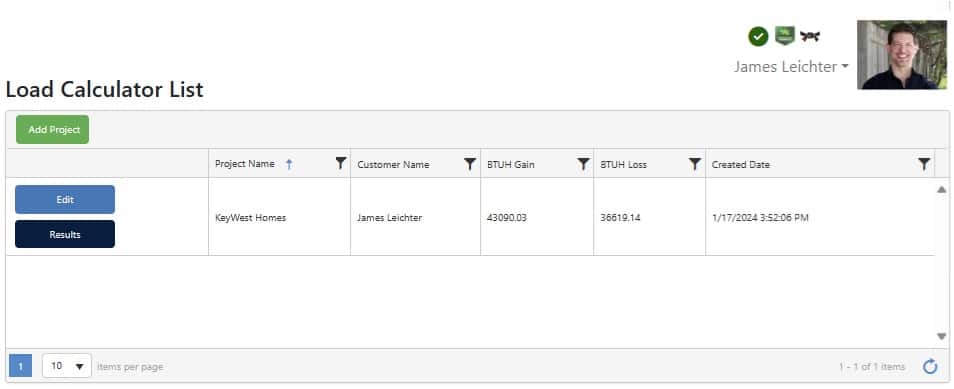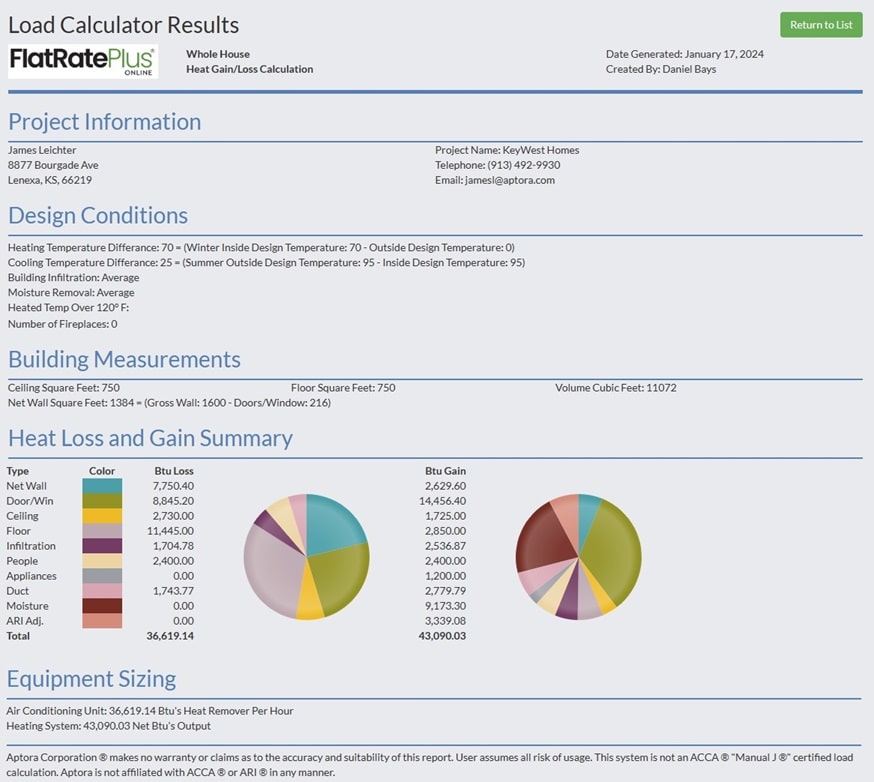HVAC Load Calculator
HVAC Load Calculations Made Easy, and Free!
Easy Load Calculator is a free Heat Load Calculation app. You will find it under the menu Free Resources > Calculators > Heat Gain Calculator. This free HVAC Load Calculator is intuitively designed to help you quickly calculate the recommended equipment heating and cooling capacity for any room or house.
It was specifically designed to be used by any HVAC contractor who needs fast whole-house BTU heat gain and loss load calculations. The app is built into the Flat Rate Plus Online web app.
This load calculator is used to determine the correct capacity (or size) of HVAC (heating and air conditioning) equipment. It works by calculating the total amount of heat that a structure loses or gains in one hour, using generally accepted engineering principles. The app uses the “whole house” concept. It is a software version of the one or two page “short form” heat gain/loss worksheet you might be familiar with.
Now you can determine a home’s heating and cooling requirements in minutes, allowing you to select the correct size of HVAC (heating and air-conditioning) equipment. It is fast, easy, and accurate for most typical residential homes.
This heat gain calculator was designed and developed by James R. Leichter. Known affectionally as “Mr. HVAC”, James R. Leichter has been training and coaching the HVAC industry longer that almost anyone. He has designed some of the best-known flat rate pricing software programs, HVAC Load Calculators, invoicing software, and full ERP accounting systems for the HVAC industry. James designed Easy Load Calc® in the late 1990s. It was a top selling HVAC Load Calculator for the desktop computer for over a decade.

Software App Features at a Glance
- Simple Heat Load Calculations: We don’t assume that you have an engineering degree. Easy Load Calculator was designed for those who have a limited knowledge of HVAC heat load calculations. Yet we have made it powerful enough to get the job of sizing HVAC equipment done right.
- Whole-House Load Calculation: The program was designed for a “whole-house” computation of residential heating and cooling gain and loss. You can treat different floors of the home or even large rooms as a new worksheet. In other words, perform a new calculation for each if necessary. This approach works well for many residential homes, but not all.
- Save Customer Heat Loads: You can enter customer contact information and run multiple HVAC heat gain calculations. You may save each calculation with unique name of your choice.
- Great Looking Reports: You can print any of your worksheets on most any Windows supported printer.
- Exporting Reports: All of your reports can be exported from Easy Load Calculator.
- Uses Your Company Contact Information: The reports use your company account and profile information. Your company logo is also used.
- Print Preview: You have the ability to quickly view, search, and scroll through your financial reports prior to printing them.
Tip: Same type of house again? Do you do a lot of similar floor plans? You may wish to consider describing the floor plan in the Notes field so that it is easy to identify. Call up the client or project and change the information. This is a lot easier than starting from scratch.
Heat Gain Construction Details
- Calculates heat gain and loss with temperature differentials up to 30 deg. F.
- Set floor, wall, and ceiling properties.
- Numerous window and door types are included.
- Select from a wide variety of insulation and building materials.
- Set air infiltration characteristics.
- Account for air duct heat gain and loss.
- Adjust the number of people who will normally occupy the space.
- Add adjustments for appliances. This handy for kitchens with elaborate cooking appliances.
- There is an option to include fireplaces.
- Additional items can be added. These offer you the chance to add various items that are not covered by the program. For example, you could add heat gain due to unusual appliances or tools or machinery. You may also add items to accommodate heat loss such as fresh air intakes, ventilation, or unusual construction.

Contact Our Friendly Sales Department
Would you like a quick demo or more information? Please contact us today by calling 913-276-2177 or by sending us an information/contact request.
A Basic Introduction to Heat Gain and Heat Loss Concepts

Sir Isaac Newton’s principle that “all matter seeks equilibrium” is used to describe how cold and warm air mix, leading to heat transfer in buildings.
Heat Loss: This occurs when there is a temperature differential between the inside and outside of a building. The article illustrates this with an example where the indoor temperature is significantly higher than the outdoor temperature, causing heat to escape from the building. This loss happens through exposed walls, ceilings, windows, and floors, and is also influenced by cold air infiltrating and warm air exhalating the structure. The extent of heat loss is quantified in BTUs per hour, which determines the heating system’s capacity needed to maintain indoor temperature. It’s noted that heat loss calculation differs for simple and complex structures, considering factors like building layout and multi-level heat flow.
Heat Gain: Heat gain is explained in contrast to heat loss. The article describes cold as the absence of heat, with the coldest theoretical temperature being -460°F, known as absolute zero. Earth’s average temperature is much higher, emphasizing the heat presence. The concept of heat gain is particularly relevant in the context of windows, where those facing east and west gain more heat compared to north and south-facing windows. This impacts the air distribution requirements in heating and cooling systems.
HVAC Systems and Comfort: Both heating and cooling systems are described as part of a “comfort system,” which includes not only the equipment but also the ducting for proper air delivery, circulation, filtration, and humidity control. The capacity of these systems is measured in BTUs per hour, indicating the amount of heat they can move or add within an hour.
We Also Have a Blog Post on Heat Gain Calculations
An Explanation of Building Heat Gain and Loss: The Basic Principles of how HVAC Load Calculations and Calculators Work, by James R. Leichter. This article is more technical, if you are into things like that.
Please contact us today by calling 913-276-2177 or by sending us an information/contact request.
